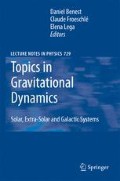Abstract
. We investigate the dynamics associated to nearly integrable dissipative systems, with particular reference to some models of Celestial Mechanics which can be described in a weakly dissipative framework. We start by studying some paradigmatic models provided by the dissipative standard maps in two- and four-dimensions. The dynamical investigation is performed applying frequency analysis and computing the di?erential fast Lyapunov indicators. After recalling a few properties of adiabatic invariants, we provide some examples of nearly integrable dissipative systems borrowed from Celestial Mechanics, and precisely the spin-orbit coupling and the three-body problem. We conclude with a discussion on the existence of periodic orbits in dissipative autonomous and non-autonomous systems.
Access this chapter
Tax calculation will be finalised at checkout
Purchases are for personal use only
Preview
Unable to display preview. Download preview PDF.
References
Beaugè, C., and Ferraz–Mello, S., 1994, Capture in exterior mean–motion resonances due to Poynting-Robertson drag. Icarus 110, 239–260.
Beaugè, C., and Ferraz–Mello, S., 1993, Resonance trapping in the primordial solar nebula: The case of a Stokes drag dissipation. Icarus 103, 301–318.
Bohr, T., Bak P., and Jensen, M. H., 1984, ransition to chaos by interaction of resonances in dissipative systems. II. Josephson junctions, charge-density waves, and standard maps. Phys. Rev. A 30(4), 1970–1981.
Broer, H. W., Simò C., and Tatjer, J. C., 1998, Towards global models near homoclinic tangencies of dissipative diffeomorphisms. Nonlinearity 11, 667–770.
Celletti, A., 1990, Analysis of resonances in the spin-orbit problem in Celestial Mechanics: The synchronous resonance (Part I). J. Appl. Math. Phys. (ZAMP) 41, 174–204.
Celletti, A., Della Penna, G., and Froeschlé, C., 1998, Analytical approximation of the solution of the dissipative standard map. Int. J. Bif. Chaos 8(12), 2471–2479.
Celletti, A., Falcolini, C., and Locatelli, U., 2004,On the break-down threshold of invariant tori in four dimensional maps. Regular Chaotic Dyn 9(3), 227–253.
Celletti, A., Froeschlé, C., and Lega, E., 2006,Dissipative and weakly–dissipative regimes in nearly integrable mappings. Discrete Cont. Dyn. Sys.—Series A 16(4), 757–781.
Coddington, E. A., and Levinson, N., 1995, Theory of Ordinary Differential Equations, McGrawHill, New York.
Correia, A. C. M. and Laskar, J., 2004, Mercury’s capture into the 3/2 spin–orbit resonance as a result of its chaotic dynamics.Nature 429, 848–850.
Darwin, G., 1908, Tidal friction and cosmogony, Scientific papers, Cambridge University Press 2.
D’Hoedt, S., and Lemaitre, A., 2004, The Spin-Orbit Resonant Rotation of Mercury: A Two Degree of Freedom Hamiltonian Model. Celest. Mech. Dyn. Astron. 89(3), 267–283.
Froeschlé, C., Guzzo M., and Lega, E., 2000, Graphical evolution of the Arnold’s web: From order to chaos. Science 289(5487), 2108–2110.
Froeschlé, C., Lega E., and Gonczi, R., 1997, Fast Lyapunov indicators. Application to asteroidal motion. Celest. Mech. Dyn. Astron. 67, 41–62.
Goldreich, P., 1966, Final spin states of planets and satellites. Astron. J. 71(1), 1–7.
Goldreich, P., and Peale, S., 1966, Spin–orbit coupling in the solar system. Astron. J. 71(6), 425–438.
Guzzo, M., Lega E., and Froeschlé, C., 2002, On the numerical detection of the stability of chaotic motions in quasi–integrable systems. Physica D 163, 1–25.
Henrard, J., 1993, The adiabatic invariant in classical mechanics. Dyn. Rep. 2, new series, 117–235.
Hussmann, H., and Spohn, T., 2004, Thermal orbital evolution of Io and Europa. Icarus 171, 391–410.
Kim, S. Y. and Lee, D. S., 1992, Transition to chaos in a dissipative standardlike map. Phys. Rev. A 45(8), 5480–5487.
Laskar, J., 1993, Frequency analysis for multi-dimensional systems. Global dynamics and diffusion. Physica D 67, 257–281.
Laskar, J., Froeschlé C., and Celletti, A., 1992, The measure of chaos by the numerical analysis of the fundamental frequencies. Application to the standard mapping. Physica D 56, 253–269.
Lega, E., and Froeschl`e, C., 1996, Numerical investigations of the structure around an invariant KAM torus using the frequency map analysis. Physica D 95, 97–106.
MacDonald, G. J. F., 1964, Tidal friction. Rev. Geophys. 2, 467–541.
Marzari, F., and Weidenschilling, S. J., 2002, Mean Motion Resonances, Gas Drag, and Supersonic Planetesimals in the Solar Nebula. Cel. Mech. Dyn. Astron. 82(3), 225–242.
Peale, S. J., 2005, The free precession and libration of Mercury. Icarus 178, 4–18.
Poincarè, H., 1892, Les Methodes Nouvelles de la Mechanique Celeste. Gauthier Villars, Paris.
Siegel, C., L., and Moser, J. K., 1971, Lectures on Celestial Mechanics. Springer-Verlag, Berlin.
Schmidt, G., and Wang, B. W., 1985, Dissipative standard map. Phys. Rev. A 32(5), 2994–2999.
Szebehely, V., 1967, Theory of orbits, Academic Press, New York and London.
Weidenschilling, S. J., and Jackson, A. A., 1993, Orbital resonances and Poynting-Robertson drag. Icarus 104(2), 244–254.
Wenzel, W., Biham, O., and Jayaprakash, C., 1991, Periodic orbits in the dissipative standard map. Phys. Rev. A 43(12), 6550–6557.
Author information
Authors and Affiliations
Editor information
Editors and Affiliations
Rights and permissions
Copyright information
© 2007 Springer-Verlag Berlin Heidelberg
About this chapter
Cite this chapter
Celletti, A. (2007). Weakly Dissipative Systems in Celestial Mechanics. In: Benest, D., Froeschle, C., Lega, E. (eds) Topics in Gravitational Dynamics. Lecture Notes in Physics, vol 729. Springer, Berlin, Heidelberg. https://doi.org/10.1007/978-3-540-72984-6_3
Download citation
DOI: https://doi.org/10.1007/978-3-540-72984-6_3
Publisher Name: Springer, Berlin, Heidelberg
Print ISBN: 978-3-540-72983-9
Online ISBN: 978-3-540-72984-6
eBook Packages: Physics and AstronomyPhysics and Astronomy (R0)

